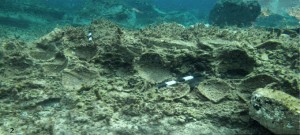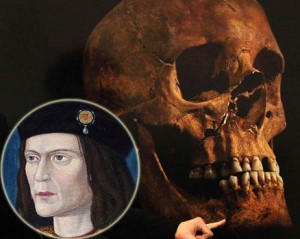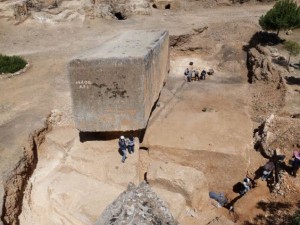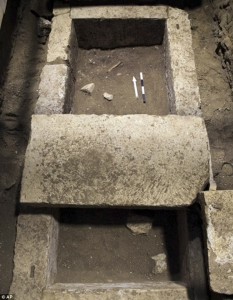Archaeologists expose lost medieval palace under prehistoric fortress at Old Sarum
The archaeological site of Old Serum situated in Wiltshire, England, has a rich history stretching back at least five thousand years. But it was William the Conqueror’s collection of the site for his royal castle in the 11th century that left the greatest mark on this historic landmark.
Now geophysical surveys have uncovered that what lies beneath the surface may actually be one of the major medieval royal palaces ever found, built within the grounds of a vast Iron Age fortress, and hidden beneath fields for more than 700 years.
The high-tech scans carried out by archaeologists from the University of Southampton, including magnetometers, earth resistance, ground penetrating radar, and electric resistivity tomography survey, have exposed the foundations of dozens of houses and an enormous, previously unknown complex, measuring 558 ft long and 14 ft wide, which is believed to have been a royal palace.
“The main applicant for constructing it is perhaps Henry I sometime in the early 12th century,” said one of Britain’s foremost experts on high rank medieval buildings, Dr Edward Impey, Director-General of the Royal Armouries.
The complex was set about a large courtyard with 3 m wide walls, and included a long building, which was maybe a grand hall. There is also proof of towers and multi-storey buildings. If it is indeed a medieval royal palace, it is the largest of its kind ever found in Britain. Up until now, archaeologists were only conscious of the much smaller complex on top of the man-made castle mound.
Old Sarum was initially an Iron Age hill fort, built in 400 BC on a site that had been inhabited since at least 3,000 BC. The site was used by the Romans, attractive town of Sorviodunum. The Saxons also used the site as a stronghold against marauding Vikings.
In the 11th century, William the Conqueror, having gained in charge of of England, chose Sarum as the site for a royal castle. The fact that it lay within a large hill fort meant that defenses could be constructed quickly. The castle was built on a motte protected by a deep dry moat in 1069, three years after the Norman Conquest. The formation of a cathedral and bishop’s palace occurred between 1075 and 1092.
A royal palace was then built within the castle for King Henry I and presently used by Plantagenet monarchs.
By 1219, the limits of freedom on the hilltop site had become reason for concern, with the cathedral and castle in close immediacy and their own chiefs in regular clash. The rejection of Old Sarum by the clergy during the 1220s marked the end of serious royal interest in the castle. The castle continued in use, but was mainly abandoned by the 16th century.
The new research has enabled archaeologists to piece together the layout of the old medieval city, shedding new light on the urban preparation of a Norman city. While the significance of Old Sarum has been known about for some time, only now are archaeologists beginning to piece mutually the long-vanished city buried under the green fields that thousands of tourists visit every year.
Richard III remains confirmed through a DNA test
Ancient bones exposed under a parking lot have been confirmed as those of the medieval king Richard III, through a DNA test that also raises questions about the legitimacy of Henry VIII and other well-known English royals.
The team of genetics detectives reported Tuesday that DNA from the skeleton shows that the bones were Richard III’s, with a probability of 99.9994 percent.
Archaeologists had peeled back a parking lot in 2012 to dig the skeleton, which was among hidden relics of the Greyfriars Friary in Leicester, England, long the reputed funeral site of Richard III.
Earlier this year, a forensic study of the relics exposed that the doomed king—the last English. Monarch to die in combat—suffered 11 wounds at the time of his death, in a 1485 fight with the Tudors that ended England’s War of the Roses.But there had been remaining questions about whether the skeleton was really that of Richard III.
“The proof directly indicates that these are the leftovers of Richard III,” says geneticist Turi King of the University of Leicester in the U.K., who led the team reporting the results in the journal Nature infrastructure.
The scientists examined DNA hereditary along maternal lines, known as mitochondrial DNA, from two distantly connected modern-day relatives of Richard III’s sister. That DNA is a near ideal match for the maternal genes of the hunchbacked skeleton covered at the friary. What’s more, the DNA was “unusual,” King adds, containing stretches that don’t quite match anything in registries of European genes.
A numerical analysis led by David Balding and Mark Thomas of University College London took those inherent results and considered the chances that a man of Richard III’s age with battle wounds and a curved spine could turn up at Greyfriars and not be the slain king. They predictably expected that chance at 6.7 million to 1.
It is amazing how many people initially argued that these skeletal remains weren’t those of Richard III,” says bioanthropologist Piers Mitchell of the U.K.’s University of Cambridge,
In 2012 archaeologists peeled back a parking lot to excavate this skeleton, buried among rest of the Greyfriars Friary in Leicester, England.
World’s Largest Ancient Stone Block Is Found
German archaeologists working at the Baalbek site in Lebanon have exposed the largest known ancient block.
The fully uncovered block, which dates back to around 27 B.C., is the well known Hajjar al-Hibla. It’s placed in a stone quarry at Baalbek, site of the first Heliopolis in Lebanon. Similar stone blocks measuring up to 20 meters (65 feet) in length and a diameter of 4 x 4 meters (13 x 13 feet) were used for the platform of the huge Temple of Jupiter in the Roman sanctuary of Baalbek.
Archeologists previously determined that Hajjar-al-Hibla was probably left in the quarry because its edges had low-quality stone that might get damaged during transport. Further excavations will try to determine whether the bigger stone block suffered the same fate.It was presumably cut for use in a Roman temple—before ancient builders determined that it wasn’t up to snuff.
A few months before, a team from the German Archaeological Institute conducted excavations at the dig, and to their astonishment they found an ever bigger stone just off to the side and underneath it. It measures 19.6 meters (64 feet) in length, 6 meters (19.6 feet) wide, and is at least 5.5 meters (18 feet) high. Its weight is predictable at a daunting 1,650 tons (that’s 3,300,000 pounds or 1,496,850 kg). Future excavations will prove its exact dimensions.
The archaeologists concluded that because of the stone’s design and level of smoothness, the block was meant to be transported exclusive of being cut. It’s thus the biggest stone block known from remains. They’re now investigating why the stone was not done and remained in the quarry and by what means the Roman builders had to transport it.
Archaeologists discover ‘underwater Pompeii’ off shore of Greek island Delos
 Archaeologists have found an ancient settlement lying under the Aegean Sea, just off the shore of the Greek island of Delos.
Archaeologists have found an ancient settlement lying under the Aegean Sea, just off the shore of the Greek island of Delos.
According to the researchers at the National Hellenic Research Foundation and the Ephorate of Undersea Archaeology, the skeleton, which are being referred to as “small underwater Pompeii” by the local media, live 6ft below the surface.
There was also a pottery workshop exposed on the sea bed, similar to those unearthed in Pompeii and Herculaneum, and the Greek Ministry of Culture announced that the residue of a kiln and 16 terracotta pots, disprove the former viewpoint that the ruins were part of a harbor.
Meanwhile, leftovers of numerous other buildings were also found, which possibly distorted before becoming hidden under water.
Delos, which is the origin of Greek gods Apollo and Artemis, is under on-going dig and several artifacts that were discovered have been put on exhibit at the Archaeological Museum of Delos and the National Archaeological Museum of Athens.
The settlement is another sews in the tapestry of Delos, which is one of the most significant mythological, historical and archaeological sites in Greece.
Its landmarks contain the House of Cleopatra, the Temple of Isis and the Sacred Way.
Archaeologists Found Skeleton Inside Alexander The Great-era Tomb
Archaeologists in Greece have exposed a skeleton from a tomb dating back to the age of Alexander the Great. The excavation has refueled rumors about the Greek conqueror, whose final resting place leftovers a secrecy.
Greece’s Culture Ministry established that an excavation site in the country’s north had once again produced thrilling results, namely, that of a skeleton.
An archaeological team digging around 370 miles north of Athens near the city of Amphipolis in latest months exposed the bones in the third chamber of the huge tomb. According to preliminary information, parts of the skeleton were scattered around a rectangular wooden casket, which had been hidden under the floor of the cavernous room
The resident was probably some “outstanding personality, a great general,” head archaeologist Katerina Peristeri said.
Nearly whole statues and expansive mosaics have fascinated the team, which is slowly making its way through the mysterious tomb. While the luxury points to a final resting place for a significant person, the archaeologists on site still do not know to whom it belonged.
The finding of a skeleton was “a very significant find because it will help us learn the sex of the person buried there and possibly their estimated age,”
The tomb houses complicated mosaics including this one of the Rape of Persephone
The tomb dates back to the time throughout which Alexander the Great ruled much of the nearby area. Born in 356 BC, the young king of Macedon launched a victorious military campaign through the Middle East, nearly into Asia to modern-day India, as well as into northeastern Africa.
Alexander the Great’s final resting place is assumed to be in Alexandria, Egypt. However, the findings of the current dig in northern Greece have re-fuelled rumor that perhaps he had been buried closer to his home after all.



